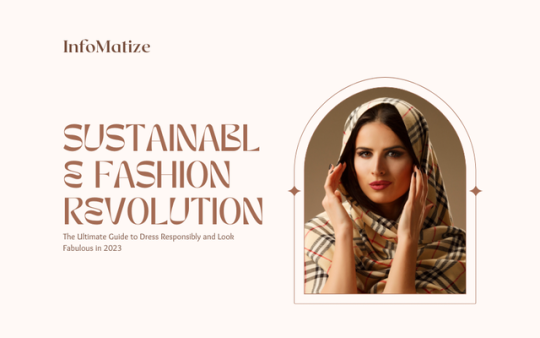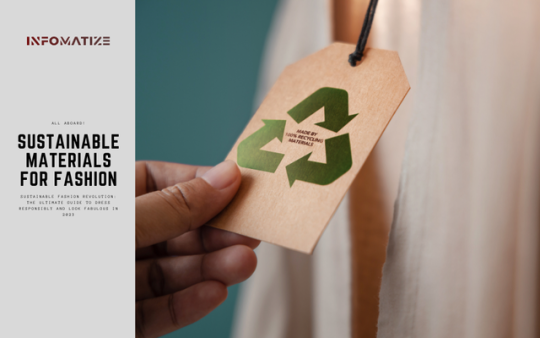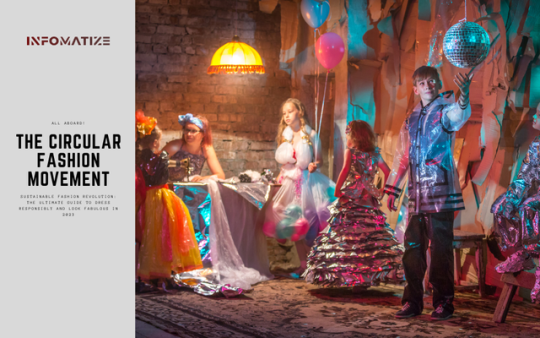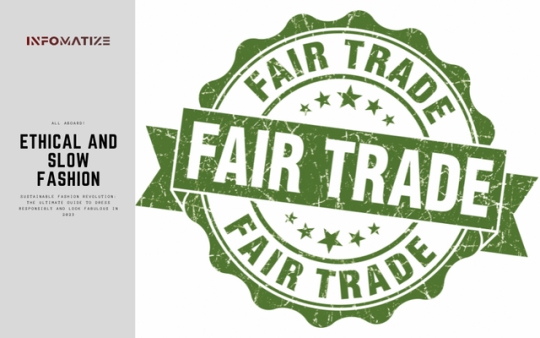#SustainableClothingBrands
Explore tagged Tumblr posts
Text
Sustainable Fashion Revolution: The Ultimate Guide to Dress Responsibly and Look Fabulous in 2023

Introduction
Sustainable fashion has gained significant attention in recent years, as consumers and brands alike are becoming more aware of the negative impact of the fashion industry on the environment and society. Sustainable fashion refers to the production, use, and disposal of clothing items in an environmentally responsible and socially conscious manner. Here are some key takeaways from the provided web search results regarding sustainable fashion and how it can help us dress responsibly in 2023: - Sustainable fashion is an emerging trend in the fashion industry, but progress remains slow . - Creating a greener wardrobe is a simple step towards sustainability. It involves taking stock of your existing wardrobe, choosing sustainable fabrics, and supporting sustainable brands . - Sustainable fashion brands use natural or recycled fabrics that require less or no chemical treatment, less water, and less energy. Some of the most sustainable fabrics include linen, hemp, organic cotton, and Tencel . - There are several sustainable fashion brands that offer stylish and environmentally friendly clothing options. These brands source upcycled fabrics and eco-minded materials for their clothing, and prioritize ethically sourced and sustainable materials and working conditions. Some of the top sustainable fashion brands include Christy Dawn, Reformation, Cuyana, Amour Vert, Whimsy + Row, and Mara Hoffman . - Sustainable fashion is a key step towards dismantling the fast fashion industry, which is responsible for more greenhouse gas emissions than the shipping and aviation industries combined . - Sustainable fashion is also gaining traction among consumers. A 2020 report on sustainability in fashion found that 67% of shoppers now consider environmentally friendly fabrics when choosing a brand . - The fashion industry is taking steps towards sustainability, such as Copenhagen Fashion Week's sustainability requirements for participating designers, with the goal of setting a new industry standard . In conclusion, sustainable fashion is a key aspect of dressing responsibly in 2023. By choosing sustainable fabrics, supporting sustainable brands, and taking steps towards a greener wardrobe, we can contribute to a more environmentally friendly and socially conscious fashion industry.
Sustainable Materials for Fashion

Sustainable fashion has gained increasing attention in recent years due to the negative environmental impact of the fashion industry. Several sustainable materials can be used in a fashion that minimizes waste, reduces carbon emissions, and conserves natural resources. Some of the most commonly used sustainable materials in fashion include organic cotton, recycled cotton, hemp, linen, bamboo, cork, ECONYL® recycled polyester, Lyocell, Modal, ECOVERO™, Piñatex, and Bananatex® . The fashion industry's conventional raw materials sourcing has contributed significantly to the planet's declining health, including petroleum refining for polyester, water contamination and depletion, soil degradation, and deforestation for industrial cotton and viscose production. Consequently, the industry is turning to sustainable materials that prioritize the environment and promote ethical practices in production. Polyester, which accounts for approximately 65% of all clothing, is produced from fossil fuels and consumes 70 million barrels of oil annually, causing significant pollution to the environment. Similarly, the fashion industry uses considerable amounts of fossil fuel-based plastic for packaging and hangers. Less than one per cent of clothing is recycled to make new clothes, which contributes to significant waste generation in the industry . Wool is another sustainable fabric that can be produced sustainably, depending on how it's made. Climate Beneficial™ Wool produced on carbon farming landscapes captures carbon and puts it back into the soil. Wool is also compostable, insulating, and does not shed plastic microfibers . Several sustainable materials are emerging, and luxury brands are turning to them to respond to customer demand for greener textiles. Examples include mushroom leather and pineapple fabric, which are gaining popularity and could play a significant role in sustainable fashion in the future . Several sustainable fashion brands prioritize using sustainable materials in their production, including Outerknown, which sources 90% of its fibres from sustainable materials such as recycled mango fruit, organic cotton, recycled Polyurethane (PU) leftovers, and environmentally-certified leather. Similarly, Reformation, based in Los Angeles, uses upcycled sneakers made of sustainable materials such as recycled mango fruit, organic cotton, recycled Polyurethane (PU) leftovers, and environmentally-certified leather. . Other sustainable materials include linen and hemp, which were commonly used in clothing in the past. Hemp is three times stronger than cotton, UV-resistant, durable, breathable, and can be grown without fertilizer or pesticides. It also requires less water to grow compared to cotton . Recycled plastic bottles are also a sustainable material used in fashion production, and they are being adopted by many designers due to their eco-friendliness . In conclusion, several sustainable materials are available for use in fashion production, ranging from organic and recycled cotton, hemp, linen, and bamboo to mushroom leather and pineapple fabric. Sustainable fashion brands prioritize The Rise of Recycled Materials in Sustainable Fashion Sustainable fashion has become a growing trend in the fashion industry, and the use of recycled materials is one of the ways that fashion brands are becoming more eco-friendly. Recycled materials, such as organic cotton, hemp, and linen, are being used in fashion lines to reduce waste and carbon emissions. Some fashion brands are even implementing compostable packaging and branding to further reduce their environmental footprint . The use of recycled materials in sustainable fashion is not only beneficial to the environment but it can also be implemented through fair labour practices, such as the Maasai beadwork. Additionally, upcycling, a process that transforms waste and byproducts of manufacturing into new products, has gained popularity in the fashion industry. Designers like Ancuta Sarcas have even started upcycling discarded Nike shoes and high-waste materials like mesh to create unique fashion pieces . The COVID-19 pandemic has further accelerated the demand for eco-friendly fashion. Fashion brands, manufacturers, and traders are looking at more sustainable approaches to meet the market demand for products meeting environmental, social, and governance (ESG) criteria. Carbon emissions reduction is also one of the targets of global efforts to promote sustainable economic development . Overall, recycled materials are becoming increasingly prevalent in a sustainable fashion as designers and brands look for ways to reduce waste and carbon emissions while still producing stylish and unique fashion pieces. Organic Cotton: The Benefits for the Environment and Your Wardrobe Organic cotton is cotton grown without the use of synthetic chemicals such as fertilizers, pesticides, or genetically modified organisms (GMOs). It offers various benefits to the environment and to the people wearing the clothes made from it. One of the most significant benefits of organic cotton is that it requires much less water to grow compared to conventional cotton. The farming process used in organic cotton production relies on rainwater for about 80% of its needs, resulting in approximately 71% less water used overall . Additionally, organic cotton cultivation methods avoid the use of synthetic fertilizers, which can lead to soil degradation and pollution of water sources, ultimately helping to prevent water contamination . Furthermore, organic cotton production methods play a role in mitigating climate change by avoiding the use of synthetic chemicals, reducing energy consumption, and sequestering carbon more efficiently in healthier soils . As such, it has been established that organic cotton cultivation has significant environmental benefits, such as promoting biodiversity, reducing greenhouse gas emissions, and helping to prevent soil erosion and degradation . Aside from its environmental benefits, organic cotton is also better for the farmers who grow it. They are not exposed to harmful chemicals that can cause a range of health problems, including respiratory issues and cancer . Moreover, organic cotton is also softer and less likely to cause irritation than conventional cotton, making it a better choice for those with sensitive skin . In summary, the benefits of organic cotton are numerous, and it is an excellent choice for those looking to reduce their impact on the environment while also supporting the health and well-being of farmers and consumers. The Future of Sustainable Textiles: Innovations and Breakthroughs Sustainable textiles are becoming increasingly important in the fashion industry. Several recent developments suggest that innovative and groundbreaking new textiles are on the horizon. Researchers at MIT are exploring the intersection of textile research and sustainable materials, seeking potential synergies that could advance the field . McKinsey and Company predict that there will be significant growth in sustainable fashion consumption, particularly in products made from more sustainable materials such as organic cotton . Science Daily reports on new textiles that can change shape when heated, potentially offering designers a wide range of new options for responsive and adjustable aesthetics . Drapers Online covers a variety of textile innovations, offering insights into the latest developments in the industry . Finally, the European Commission has launched a roadmap for the future of sustainable textiles in the EU, outlining efforts to increase the circularity of the fashion ecosystem . With these developments and more, it seems clear that sustainable textiles are an area of rapid innovation and growth, and we can expect exciting breakthroughs in the near future.
The Circular Fashion Movement

The Circular Fashion Movement is a growing global trend in the fashion industry that aims to promote sustainable and responsible production and consumption of clothing while reducing the negative impact of the fast fashion industry on the environment and society. Circular fashion involves designing, producing, and using clothes that are meant to be used and circulated responsibly and effectively for as long as possible, and then safely decomposed or repurposed when they are no longer of use to humans . The movement has gained significant momentum in recent years, with numerous fashion brands and organizations committing to circularity commitments and initiatives, such as take-back and resale programs, upcycling, and closed-loop production systems . The Circular Fashion Pledge is a simple concept that asks fashion brands to pledge to one or more circularity commitments by the end of the calendar year, such as enabling take-back or resale programs . Circular fashion has been identified as a key solution to the environmental and social challenges posed by the fast fashion industry, including waste, pollution, exploitation of labour, and depletion of resources . The movement has also gained significant attention and support from sustainability experts and advocates, who believe that it can help to create a more equitable, resilient, and sustainable fashion industry that benefits both people and the planet. Overall, the Circular Fashion Movement represents a growing global trend towards more sustainable and responsible fashion production and consumption and has the potential to revolutionize the way we approach clothing and fashion in the future. Understanding Circular Fashion: What It Is and Why It Matters Circular fashion is a concept that has emerged from the intersection of the circular economy and sustainable and ethical fashion . Essentially, it refers to a system in which all garments can be reused, recycled, or returned to the earth (by virtue of being biodegradable or compostable), reducing the hugely damaging impact the fashion industry has on the planet . In other words, products are designed and developed with the next use in mind, with the aim of keeping resources in use for as long as possible and minimizing waste . The fashion industry has long been known for its negative impact on the environment, including the strain on natural resources, the vast amount of CO2 emissions it produces, and the giant heaps of clothing that end up in landfills . Circular fashion is one solution to this problem, as it aims to reduce the harmful impact of fast fashion by circulating and reusing articles for as long as possible before decomposing them safely . Circular fashion also means using sustainable and natural materials in production, such as organic cotton, bamboo, and Tencel, and avoiding synthetic and plastic fabrics like polyester and nylon derived from fossil fuels . Additionally, the production and transport of items should be powered by renewable energy sources . In summary, circular fashion is a sustainable and ethical approach to fashion that aims to reduce waste and minimize the harmful impact of the industry on the environment. It involves reusing, recycling, and upcycling as much as possible, using sustainable and natural materials, and powering production and transport with renewable energy sources . From Cradle to Cradle: The Principles of Circular Fashion Design Circular fashion design principles are heavily influenced by the cradle-to-cradle (C2C) approach, which is a design framework for creating products that mimic natural systems and support the circular economy. The C2C approach promotes the high-quality use and circulation of biological and technical nutrients, protecting and enriching ecosystems while enabling economic productivity . The aim of the C2C approach is to optimize products from the molecular to modular level and establish these principles in all industry sectors, including the textile industry, consumables, buildings, automotive, packaging, and cosmetics . Circular fashion design principles follow the four principles of the circular economy: preservation of natural capital, optimization of available resources, risk reduction, and renewable flow of resources and products . The principles of circular fashion design also emphasize the importance of planning the entire lifecycle of a product at the design stage, incorporating aspects such as sustainable materials, biodegradability, recyclability, and durability. Circular fashion aims to eliminate waste, pollution and the negative environmental impact of the fashion industry, by designing products for reuse, recycling, and composting . Closing the Loop: How Brands are Embracing Circular Fashion Circular fashion refers to a closed-loop system that rethinks and redesigns the way products are made, used, and discarded to reduce waste and promote sustainability. Many fashion and luxury companies, including LVMH, Kering, H&M, VF Corp, and Gap, have embraced circularity as a way to reduce their environmental footprint . A fully closed-loop apparel recycling system in California could achieve a total holistic impact of $11 billion to $13 billion a year, based on the estimate of the total holistic impact of approximately $5.5 billion to $6.5 billion from closed-loop recycling of polyester, which represents a significant portion of textile production . In order to combat unethical practices in the fashion and textile industry, the industry must embrace a closed-loop system, rethinking and redesigning the way products are made, used, and discarded . Many fashion brands are now working towards closing the loop on waste and promoting circular design, such as Loop Swim, a brand that transforms post-consumer plastic bottles into sun-protective swimwear . In February 2022, Reformation launched RefRecycling, a program that allows customers to return any well-worn Ref goods to the company to be recycled, thus promoting circular fashion and reducing waste .
Ethical and Slow Fashion

Ethical and slow fashion are two related concepts that are gaining more attention in the fashion industry. While they share some similarities, they also have distinct differences. Ethical fashion focuses on ensuring fair treatment of workers throughout the supply chain, from safe working conditions to fair wages and eliminating child and slave labour . It also considers the treatment of animals, making sure that the materials used in clothing production are cruelty-free . On the other hand, slow fashion is about producing high-quality, timeless clothing that is sustainable and environmentally friendly . Slow fashion leans into sustainable practices, such as using eco-friendly materials and minimizing waste . Both ethical and slow fashion is countercultural, going against the current societal norms that prioritize fast and cheap production over ethical and sustainable practices. Hallmarks of slow fashion include longer production timetables, fewer items produced, and more ethical labour practices, with an emphasis on creating timeless pieces that will stand the test of time . In summary, ethical fashion is focused on the fair treatment of workers and animals throughout the supply chain, while slow fashion is about sustainable and timeless clothing production. Both concepts are aimed at creating a more sustainable and ethical fashion industry, challenging the norm of fast and cheap fashion production. Slow Fashion: The Antidote to Fast Fashion Slow Fashion is an approach to clothing production that takes into account all aspects of the supply chain, including the environmental and social impact, as well as animal welfare. It aims to create sustainable, ethical, and high-quality garments, produced on a smaller scale with more eco-conscious materials and locally manufactured to reduce transportation and promote fair wages for workers . In contrast to fast fashion, where clothing is produced quickly and cheaply with a focus on trends and low prices, slow fashion considers the long-term impact of the production process and encourages consumers to value quality over quantity . If you're interested in adopting slow fashion practices, here are a few tips to get started: - Have a clear-out of your closet and donate or sell the clothes you don't wear anymore to avoid cluttering and promote the use of existing garments . - Buy clothes made from sustainable and eco-friendly materials such as organic cotton, recycled fabrics, or biodegradable fibres . - Choose locally-produced garments to support your community and reduce the environmental impact of transportation . Read the full article
#Consciousfashion#Eco-consciousfashion#Eco-friendlyclothing#Eco-friendlyfashion#Ethicalclothing#Ethicalfashion#Fashionrevolution#Responsiblefashion#Slowfashion#Sustainableclothingbrands#Sustainablefashion#Sustainablefashionbloggers#Sustainablefashionbrands#Sustainablefashionforallages#Sustainablefashionforallbeliefs#Sustainablefashionforallbodytypes#Sustainablefashionforallbudgets#Sustainablefashionforallcelebrations#Sustainablefashionforallclimates#Sustainablefashionforallcultures#Sustainablefashionforallethnicities#Sustainablefashionforallevents#Sustainablefashionforallgenders#Sustainablefashionforallhobbies#Sustainablefashionforallholidays#Sustainablefashionforallinterests#Sustainablefashionforalllifestyles#Sustainablefashionforalllocations#Sustainablefashionforallnationalities#Sustainablefashionforalloccasions
2 notes
·
View notes
Text

Get a TOASTY tee! These long-lasting shirts are 🫠
Made from hemp and recycled water bottles ♻️🌊
#hemp#hempcommunity#hempclothing#nothing but hemp#recycled#ecofriendly#sustainableclothingbrands#cutecore#cute cartoon#cartoon
1 note
·
View note
Text
The Rise of Sustainable Clothing: Empowering Fashion for a Greener Future
As the world becomes increasingly aware of the environmental impact of the fashion industry, a new movement is gaining momentum - sustainable clothing. From the sourcing of materials to manufacturing processes and end-of-life disposal, sustainable clothing aims to minimize harm to the planet and promote a greener future. In this article, we will explore the concept of sustainable clothing, its benefits, and how it is shaping the fashion industry.

Defining Sustainable Clothing:
Sustainable clothing refers to garments that are produced with consideration for the environment, social responsibility, and ethical practices. It encompasses various aspects, including the materials used, the manufacturing processes employed, and the treatment of workers throughout the supply chain. The primary goal of sustainable clothing is to reduce the carbon footprint, conserve resources, and create a positive impact on both people and the planet.
Eco-Friendly Materials:
One of the key pillars of sustainable clothing lies in the use of eco-friendly materials. This involves sourcing organic fibers such as organic cotton, hemp, and bamboo, which are grown without the use of harmful pesticides and require less water compared to conventional crops. Additionally, innovative materials like recycled polyester, regenerated fibers from post-consumer waste, and biodegradable fabrics are gaining popularity in sustainable fashion, reducing dependence on non-renewable resources.
Ethical Manufacturing:
Sustainable clothing also emphasizes ethical manufacturing practices. This includes fair wages and safe working conditions for garment workers, ensuring their well-being and empowerment. Brands committed to sustainability often prioritize transparency, traceability, and compliance with labor rights to ensure a fair and just supply chain. By promoting ethical manufacturing, sustainable clothing aims to create a positive impact on both local communities and the global fashion industry.
Circular Fashion:
A significant shift in the fashion industry is the adoption of circular fashion principles by sustainable clothing brands. Circular fashion focuses on reducing waste and extending the lifespan of garments through recycling, upcycling, and repair programs. By encouraging consumers to buy less but buy better quality, durable clothing, sustainable fashion aims to minimize the environmental impact associated with fast fashion and the throwaway culture.
Consumer Empowerment:
The rise of sustainable clothing is strongly driven by consumer demand for eco-friendly and socially responsible products. As consumers become more conscious of their purchasing decisions, they are actively seeking out sustainable fashion brands and supporting their efforts. Through education, awareness campaigns, and accessible information, consumers are empowered to make informed choices, encouraging the industry to prioritize sustainability.
Collaboration and Innovation:
To accelerate the transition to sustainable clothing, collaboration and innovation play crucial roles. Brands, designers, manufacturers, and consumers are coming together to explore innovative solutions and implement sustainable practices. This collaborative approach promotes knowledge sharing, technology advancements, and the development of new business models that challenge the traditional linear fashion system.
Conclusion:
Sustainable clothing represents a paradigm shift in the fashion industry, addressing the urgent need for environmental and social responsibility. By embracing eco-friendly materials, ethical manufacturing, circular fashion, and consumer empowerment, sustainable clothing paves the way for a more sustainable future. It is not merely a trend but a conscious choice towards preserving our planet and ensuring a better world for generations to come. As consumers, let us embrace sustainable clothing and contribute to the positive transformation of the fashion industry.
#sustainableclothing#sustainableclothingformen#sustainableclothingforwomen#Sustainableclothingbrands#BuySustainableClothes
0 notes
Text
Fashionable Wholesale Sustainable Clothing at Unbeatable Prices-USA Clothing Manufacturer

Need a trusted source for wholesale sustainable clothing manufacturer? We offer a range of comfortable, bulk clothes. Contact us today for wholesale orders.
#sustainableclothingmanufacturer#recycleclothing#recycleclothingbrands#recycleclothingcompany#sustainableclothingbrands#sustainableclothing#bestsustainableclothingbrands#affordablesustainableclothing#cheapsustainableclothing#sustainableclothingcompany#sustainableclothingcompanies#wholesalesustainableclothing#sustainableclothingwholesale#ethicalsustainableclothing#women'ssustainableclothing#sustainableclothingbrand#menssustainableclothing#men'ssustainableclothing#organicsustainableclothing#inexpensivesustainableclothing#sustainableclothingwomen#mensustainableclothing#ecofriendlysustainableclothing#sustainableclothingforwomen#menssustainableclothingbrands#sustainableclothingformen#sustainableclothingwebsites#sustainableclothingmanufacturers#ethicalsustainableclothingmanufacturer#sustainableclothingmanufactureraustralia
0 notes
Text
https://www.atelange.com/do-indian-farmers-need-fair-trade-clothing-as-a-lifeline/
#sustainable fashion#sustainableclothing#tshirtbrand#fairtradefashion#ethical fashion#sustainableclothingbrand#women fashion#india#madeinindia
0 notes
Text

Relaxed Fit, Half Puff Sleeve Mini Dress With A Keyhole Neckline Crafted In Lyocell, Hand Block Printed With Our Signature Fern Motif Using Azo-Free Dyes. A Staple Summer Dress Is A Must For Any Sustainable Wardrobe. This Piece Is Made In Fabric That'S Created From Wood Cellulose Fibres (Natural And Renewable).
#ethicalfashionbrands#ethicalfashion#ecofashion#everydayoutfit#sustainableclothingbrand#outfit#concious fashion#slowfashion#handmadewithlove#outfit inspiration
0 notes
Text
Brand Story of Threadgame : When, Why & How it become india's first choices
When it came name of fashion The Threadgame will be mention by the fashionistas.Our journey become the loveable brand amongs women just because we are using Natural color and materials for more comfort and elegant looks. we always believe in the product and process of making the fine product with designing cloths. We are becoming the indian top brand as organic and natural clothing brand with smooth delivery service all along India.

#threadgame#Organicclothingbrand#Indianclothingbrand#Brandedcloths#Naturalclothingbrand#sustainableclothingbrand#womenfashion#clothing#accesorios
1 note
·
View note
Photo

When you wear LENNY, you wear something that stands apart — and stands for style. We hand dye, hand stitch, and embroider each item of clothing because the traditional “rules” of fashion just aren’t for us. Get in touch with us today.
#EthicalWomen'sClothing#TrendyDenimJacket#WomenLongJumpsuit#TrendingClothesForWomen#LatestWomenFashion#WomenDenimJacket#WomenClothingSets#HandmadeWomen'sClothing#SustainableClothingBrands#Eco-FriendlyClothing#SustainableWomen'sClothing
1 note
·
View note
Link
1 note
·
View note
Photo

@muddy_247 rocking our Quad Fin crew neck around Saltburn. We absolutely love salty. Spent so many evenings there catching sunset waves after work. Said he even got a fist bump from a local surfer 🤙🏻 #surfclothes #ecofriendlyproducts🌿 #recycledstyle #sustainableclothingbrands #coastallove #beachsurfing #surferbeach #surfwearclothing #surfclothings #surfclothingbrand #surfingclothing #surfingculture #surfandskatelovers #surfparadise #surfwear #sustainableclothing #surfskate #surfing #surfboard #surfers #surfculture #surfsup #surferlife #surfporn #saltyhair #beachphotography #beachlover #surflife #surfinglife (at Saltburn-by-the-Sea) https://www.instagram.com/p/Ce8NLJdIP7Q/?igshid=NGJjMDIxMWI=
#surfclothes#ecofriendlyproducts🌿#recycledstyle#sustainableclothingbrands#coastallove#beachsurfing#surferbeach#surfwearclothing#surfclothings#surfclothingbrand#surfingclothing#surfingculture#surfandskatelovers#surfparadise#surfwear#sustainableclothing#surfskate#surfing#surfboard#surfers#surfculture#surfsup#surferlife#surfporn#saltyhair#beachphotography#beachlover#surflife#surfinglife
0 notes
Photo

Our SALE is coming to end! ⠀⠀⠀⠀⠀⠀⠀⠀⠀ Shop our sale section for up to 70% off select styles! ⠀⠀⠀⠀⠀⠀⠀⠀⠀ Sale ends Monday! ⠀⠀⠀⠀⠀⠀⠀⠀⠀ #endofseasonsale #boutiquesale #shopsmall #sustainableclothingbrands https://www.instagram.com/p/CMqBHI0BFK4/?igshid=uixwrdzqqp4t
0 notes
Text
We make t-shirts strong enough to survive anywhere in the galaxy 💪
…they also happen to be made from hemp & recycled water bottles 🤯
All this for only $25! 🤑
Learn more here ⬇️
#hemp#nothing but hemp#hempcommunity#hempclothing#industrial hemp market#tshirt#sustainableclothingbrands#best t shirts for men#streetwear#cute cartoon#cartoon
0 notes
Text
Eco Friendly Clothing For Women - Empowering Women: Reepeat

Empower yourself and the planet with Reepeat's eco friendly clothing for women. Join the movement to combat the staggering waste in the fashion industry, where over 100 billion garments are produced annually, with a staggering 87% destined for landfills or incinerators – that's approximately 40 million tons of clothing waste. At Reepeat, we're changing the narrative by offering a curated collection of sustainable fashion choices that prioritize both style and the environment.
0 notes
Link
Sustainable Vests for Women fairly seriously, particularly since they become a critical part of getting outdoors also having amazing wintertime without freezing!

#SustainableClothing#SustainableMen'sApparel#Women'sApparel#SustainableFashion#SustainableClothingBrands
0 notes
Text
Affordable Wholesale Sustainable Clothing Manufacturer In USA At Flat 40% OFF

Looking for eco-friendly and sustainable clothing manufacturing in the USA? We've got you covered.
#sustainableclothingmanufacturer#recycleclothing#recycleclothingbrands#recycleclothingcompany#sustainableclothingbrands#sustainableclothing#bestsustainableclothingbrands#affordablesustainableclothing#cheapsustainableclothing#sustainableclothingcompany#sustainableclothingcompanies#wholesalesustainableclothing#sustainableclothingwholesale#ethicalsustainableclothing#women'ssustainableclothing#sustainableclothingbrand#menssustainableclothing#men'ssustainableclothing#organicsustainableclothing#inexpensivesustainableclothing#sustainableclothingwomen#mensustainableclothing#ecofriendlysustainableclothing#sustainableclothingforwomen#menssustainableclothingbrands#sustainableclothingformen#sustainableclothingwebsites#sustainableclothingmanufacturers#ethicalsustainableclothingmanufacturer#sustainableclothingmanufactureraustralia
0 notes
Text
https://www.atelange.com/from-streetwear-to-office-wear-the-best-sustainable-mens-clothing-trends-in-india/
0 notes